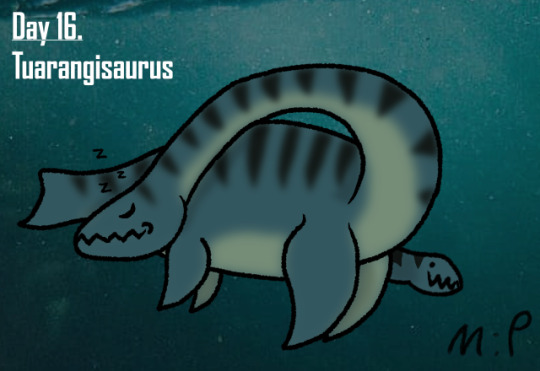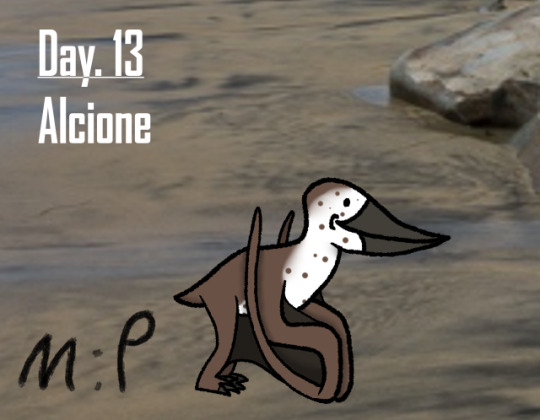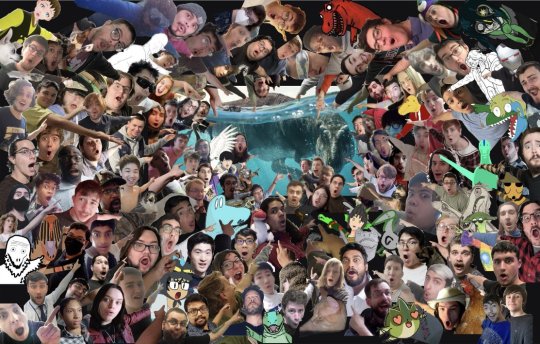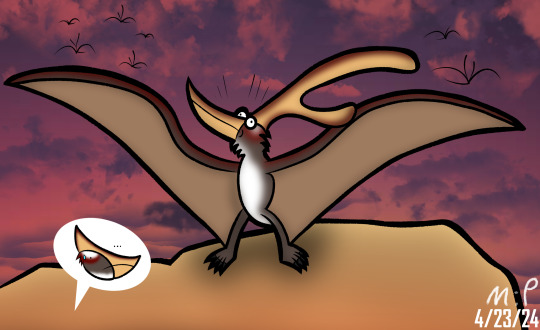#may-strichtian madness
Photo

Carnotaurus sastrei (Sastre’s meat-eating bull) is a rather curious-looking theropod. While it attained the same status of apex predator, similar to the likes of T. Rex, bodily features like its elongated body shape, the small bull-like horns that gave the beast its name, and, most shocking of all, extremely tiny arms that are even smaller than T. Rex, which is shared by other such species like Rajasaurus and Majungasaurus. While they seem like they would be absolutely useless to the animal, Carnotaurus did have one good use for its nearly vestigial arms. With the undersides being blue for show, the males of this species used their small arms in courtship dances, hoping to attract mates.
21 notes
·
View notes
Photo

With features like a snout shaped like the bill of a duck, a strange hump on its back, and a pair of claws the size of a man, Deinocheirus mirificus (Unusual terrible hand) is among the most bizarre of all dinosaurs. Once thought to be a deadly predator when the first fossils of its arms were discovered, it’s been since revealed that Deinocheirus was an omnivore, having a diet of fish and water plants. It was also part of the same family of theropods that included the famous Ornithomimus, albeit with a much more different lifestyle when compared to its smaller (and faster) relatives. It’s also one of the largest feathered animals ever discovered, even being taller than T. Rex. The claws that it used weren’t just for dredging up water plants, but also gave the animal a good scratch when blood-sucking flies came to call.
13 notes
·
View notes
Photo

“Instead of drawing mermaids for a whole month, I’m doodlin’ up dinosaurs. For a whole month. Why yes, I am COMPLETELY serious about this.”
In celebration of Prehistoric Planet’s second season releasing next month on Apple TV+, along with the official teaser trailer finally releasing today as I’m writing this, I’ve decided to dedicate an entire month to drawing 31 doodles of the beasties that appear in the show. All of the animals are from season 1, as the list for this prompt was made before any official footage for Season 2 was released to the public. If we do get enough new creatures in this new season, I might cover them in a second May-strichtian Madness next year. For now tho, we’re entirely focusing on Season 1 fauna. Alongside the second batch of PHP episode reviews made in time for the next episodes of the series, along with any other projects that pop into my head, this coming May is certainly gonna be a busy month for me. With that said, let the Madness begin!
13 notes
·
View notes
Photo

Tyrannosaurus Rex (Tyrant lizard king) was the biggest and deadliest of an already big and deadly group of predatory theropods. Being 40 feet long, 12 feet tall, and having a skull filled with railroad-sized teeth that allowed this beast to crunch through the toughest of armor, this huge tyrannosaur was the apex predator of the North American floodplains. However, despite its fearsome reputation, T. Rex was not only a good parent to its young, it, surprisingly enough, makes for a very good swimmer, often swimming to nearby islands for new sources of food.
9 notes
·
View notes
Photo

Tuarangisaurus keyesi (Māorian for ancient lizard) is a species of elasmosaur, a type of marine reptile with a long neck and small head, from the waters of the South Pacific. Like many of its cousins, this animal not only feeds on fish, it swallows round stones that aid in both buoyancy and digestion. Living in large pods like today’s whales and dolphins, these creatures protect themselves and each other from predators.
6 notes
·
View notes
Photo

Barsboldia sicinski (Named after Rinchen Barsbold and Wojciech Siciński) is a species of large hadrosaur from the deserts of Mongolia. While it’s not the most extravagant animal, whole herds of these creatures migrate across the desert in search of water, stopping at large desert oases that attract many other animals.
6 notes
·
View notes
Photo

Surprisingly huge for a frog, being at the same size as a cat, Beelzebufo ampinga (Shielded devil toad) acts as a powerful predator towards juvenile dinosaurs on the island of Madagascar. This creature got its name from Beelzebub, the Lord of the Flies, due to its size. In essence, this critter was a pacman frog on steroids.
3 notes
·
View notes
Photo

While this particular dinosaur is part of the same genus as the legendary Velociraptor mongoliensis (Mongolia’s swift thief), it still lacks a species name as of now. Despite that, it still has the famous characteristics that Velociraptor is known for; Being the size of a turkey, having a full coat of feathers used for insulation and softening its landings when in pursuit of prey, and the sickle-shaped toe claws on its feet. From preying on animals as small as tiny lizards, to even taking on young azhdarchids, Velociraptor was a real opportunist.
5 notes
·
View notes
Photo

Hailing from the same environment as the larger Barbaridactlyus, Alcione eleinus (Wandering Alcyone) is a small relative to the former, both sharing the same ecosystems and prey. While this species is smaller and more lightly-built, a good adaptation of theirs is how they make their nests on rocky islands and cliffs, away from the reach of predators. After the parents leave them, the flaplings hatch and reach the highest point, where they set out on their flight to the safety of the mist forests on the mainland. It is risky though, as they’re faced with the threat of predation from other pterosaur species.
5 notes
·
View notes
Photo

Hailing from the waters of the South Pacific, Kaikaifilu hervei (named after Kai-Kai filu, a deity of Mapuche origin, along with Dr. Franciso Hervé, the man who first discovered the animal), was a medium-sized mosasaur related to the much more famous Tylosaurus. While a big animal in of itself, Kaikaifilu was graceful and agile in the water, making it a fast and powerful threat for its prey to deal with. Fossils of this beast have been discovered as far south as Antarctica. This suggests that the general area that Kaikaifilu roamed in during the Maasritchian epoch was warmer than it was today.
4 notes
·
View notes
Text
May-srichtian Madness: Before the Madness

Time for a quick news update, folks! After months of considering the mere thought of it, I’m about to embark on my next big drawing prompt challenge; May-srichtian Madness!
Ever since a certain dinosaur show made by Apple was announced to be getting a second season on May 22 (Which is itself a mind-boggling thing that I’m wrapping my head around to this day), I was thinking on what to do in order to celebrate what’s basically the second coming for us paleo-fans. Then it dawned on me; The month that Prehistoric Planet season 2 (and by extension, the first season from last year) has a release date in May, the same month that a highly-popular drawing challenge about mermaids pops up every year. Why not do the exact same thing, but with dinosaurs?
And that, my friends, is how the general idea of May-srichtian Madness was born. It’s basically what would happen if Prehistoric Planet and Mermay had a baby together. As I’m writing this, I’m almost done with drawing the first half of the prompts done, and I hope to do the same for the second half before their days take the spotlight. I already posted the prompt list for the challenge a while back, but I feel like a quick refresher is in order.Keep in mind, this list was made a good while before we got footage for Season 2, so if you’re wondering why this list is entirely full of animals that debuted in Season 1, there’s your answer.

If this new batch of episodes brings us enough new dinosaurs, pterosaurs, marine reptiles, and etc, I might consider drawing them in a possible second May-srichtian Madness next year, but for now, the likes of Isisaurus and Pectinodon are sadly off the table. For anyone who wants to join, you’re all welcome to do so. Be sure to add in #MaysrichtianMadness (Or May-Srichtian Madness for those on Tumblr) under your prompts to join in the madness. Other projects aside from May-srichtian Madness are being considered (Including a couple of new faces to my Johnny Test reboot idea that I feel would be nice to introduce to compensate for Mermay), so in terms of that… May is certainly gonna be a busy month for me, lemme tell you.
The madness is scheduled to start next Monday on May 1, so I’ll see you all then, where the Prehistoric Planet Sweep begins once again!
3 notes
·
View notes
Photo

Being around 56 feet long, being big enough to dwarf even the mighty T. Rex, Mosasaurus hoffmani (Hoffman’s lizard of the Meuse River) is the largest predator to live on the face of the planet during the Late Cretaceous. This gigantic relative to the komodo dragon of today lived entirely in the ocean, serving as a powerful predator that can attack and devour any animal that it so chooses. However, despite its fierce reputation, this beast has a gentle side; Traveling to coral reefs, it can get scrubbed up from a cleaning station. Shrimps, pycnodont fish, and other small animals pick at the lizard’s shedding skin, ridding it of any dead bits of skin, parasites, and other such dermal issues.
2 notes
·
View notes
Photo

Dreadnoughtus schrani (Fears nothing) is big. As in, really big. Averaging at 85 feet long, and weighing 49 metric tons, this was not only one of the biggest dinosaurs, but also one of the largest animals to ever live, which is normal for titanosaurian sauropods. As the meaning of its name suggests, this behemoth truly feared nothing, due to its titanic size. Gathering in the deserts of South America, these massive titanosaurs gather to mate. Showing off weird-looking gular air sacks to the leks of females, male tend to compete in big fights over the right to mate, similar to elephant seals. If one of them falls over, the weight of their body makes it impossible for them to ever get back up again, making crashing down a guaranteed death sentence for the loser.
5 notes
·
View notes
Text

While there’s currently no news on PHP for the time being, I’m very happy to report that May-strichtian Madness is back, you MEATHEADS!
While I’m working to get my prompts done on time, they should start coming out on May 1st. And for anyone wanting to be a part of MM2, the tag is gonna be #MaystrichtianMadness, so y’all can join in on the fun.

The madness returns this week, so get ready for Round 2 of prehistoric pandemonium!
0 notes
Text

Playing hard to get.
#my artz#prehistoric planet#ultra ramblings#barbaridactylus#pterosaur#used one of the may-strichtian madness pieces from last year for a redraw
1 note
·
View note